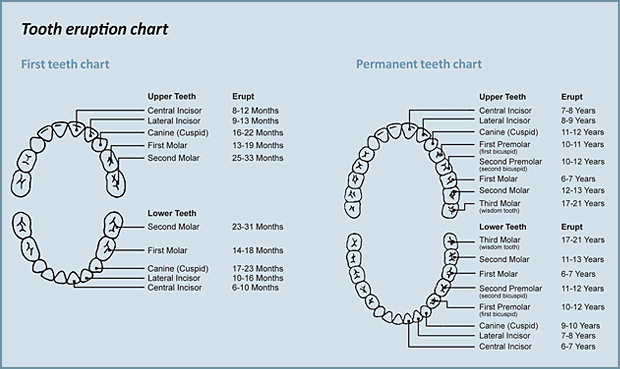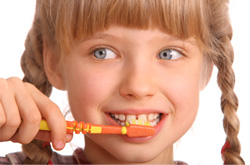
Data and statistics over time have proven that children who learn to take care of their teeth and oral health early on tend to have healthier teeth through adulthood than those who don’t develop such critical habits. As a result, dental checkups and examinations are recommended by the American Academy of Pediatric Dentistry as soon as a child starts teething or at least by one year of age. This early exam also gives dentists a chance to review and evaluate a child’s fluoride exposure which can be a significant factor in tooth decay prevention.
The above said, a pediatric dentist is especially trained in making a child feel far more comfortable at the dentist than a physician who regularly works on adults. Like everything else, there is a world of difference between a child’s set of teeth and that of an adult, and trained pediatric dentists understand this fact when performing examinations.
Pediatric dentists in Agoura Hills dental offices, much like pediatric doctors, are trained specifically to deal with children dental issues. This involves 2 to 3 more years of training under residency than a regular dentist is required to have. Once the training is completed, a pediatric dentist can work with children from infant and toddler age to teens, as well as on adults otherwise.

As noted above, the earliest a child should be seen by a pediatric dentist is when their teething begins with the first tooth eruption from the gums or at least at their first birthday. This allows a dentist to watch is happening with a child and catch issues early on. However, there is never too late of a time for a child to be seen by a pediatric dentist.
Dr. Shoreh Selki in our Agoura Hills dental office has worked with children and teenagers for decades. This experience and the team of dentists and assistances under Dr. Selki can address dental issues in toddlers via age one pediatric dentistry as well as teenagers who haven’t been regularly seen. The entire team program at Shoreh Selki DDS and process is geared toward children dentistry and making dental health a positive experience versus a negative one.

Yes, it is true that primary teeth, otherwise known as baby teeth, eventually fall out. However, this doesn’t mean that early tooth development isn’t important. They should always receive the same level of care as permanent teeth would. So just chalking off cavities in a child with baby teeth is a big mistake.
Primary teeth help with the spacing and normal development of a child’s face. If baby teeth grow in wrong or disappear too early, permanent teeth growing in afterward have a higher chance of developing crooked, which triggers more care and work later on to remedy. With primary teeth well-cared for, when they drop out, permanent teeth come in correctly and grow right where they should.
Failure to care for baby teeth can also create pain for a child that isn’t necessary to go through. Further, decay or a tooth infection has the possibility of also affecting new permanent teeth still developing within the jaw bone.

The first visit is often primarily introductions, getting a new child used to the idea of having his or her teeth examined, and taking base information that will set the stage for tracking dental development. Your child and you will be shown the entire office and how Dr. Salki’s program works as well as how comfortable the environment is for both you and your child. Parents are completely welcome in the examination room and babies and toddlers are often allowed to be on a parent’s lap for security and a stress-free exam. This approach often works better with young children seeing a dentist for the first time.
For older children the review will often focus more on medical history as well as a full dental exam, including x-rays and cleaning.
Preventive care can include realignment using Damon Braces or Invisalign Teen options.
Where dental surgery is necessary, Dr. Salki's staff will have a full review of options made available to parents for affordable dentistry, including both in-house work using nitrous oxide sedation as well as referrals to advanced oral surgery services.

This information is important for us in making correct diagnosis as well as a suitable treatment for your child. We often modify our treatment recommendations based on your child’s specific needs.
Our doctors always evaluate and discuss the need for topical Fluoride application with the parents during the initial visit.
X-rays are essential in making a comprehensive diagnosis.
We will review the sequence of the erupting permanent teeth as well as what to anticipate for the next few months.
Health dietary recommendations are discussed based on their age. Our primary goal is prevention of dental cavities through encouraging a healthy diet and good oral hygiene.
We teach children how to care for their teeth by showing them proper brushing, flossing, and using mouth wash.
Your child’s wellbeing is our priority.
If there is a need for dental treatment, we work closely with parents to discuss and explain all treatment options.
A normal exam schedule for children as well as teenagers averages six months. However, where there are existing issues such as cavities or similar, a dentist may move the scheduling up to every four months for increased review and prevention activity. This can often be the case where a child has a number of cavities or there are issues with keeping teeth clean. How often x-rays are apply as well as professional fluoride treatments depends on the dentist’s evaluation of need for a specific case.

There is no specific date on when a given child will start to see his or her new teeth break through the gum line. Normally, the growing teeth begin to erupt anywhere between six and ten months in the first year of age. The lower front teeth often make the first appearance before anything else. This can be irritating as a child feels something different and then the teeth make contact with the gumline above. Ergo irritation and pain, which is often referred to as teething. The remaining teeth start coming in through the gumline following the first front ones, and a full set of teeth is usually seen at about 2 years of age. By age 3, a total of 20 baby teeth will be in place.
For about three years, sometimes less, there is a break, and then the baby teeth begin to fall out. The first to go will be the front teeth, usually the bottom ones. New, permanent teeth begin to appear at age 6 once a vacancy in the gumline exists. The remaining molar teeth begin to start coming out as well. All of this activity will continue to change a child’s mouth until about as late as age 14.

The frequency and number of cavities a child or adult may develop are a result of a combination of factors. Yes, diet has a lot do with the potential. A heavy sugar diet will definitely increase the potential of cavities, providing the means for enamel decay, allowing a cavity to develop. However, other factors are involved as well.
Oral bacteria is a big player in the start of cavities. This element begins after children share an environment with adults as babies have no oral bacteria at all when born. They receive it from their parents through spoon sharing and kissing. To reduce this bacteria introduction for as long as possible, spoons should be cleaned before providing them to a child, even a mother thinks there’s nothing wrong with sharing. Additionally, cheek-kissing avoids any close contact through which bacteria can transfer as well. By reducing the possibility, a child has a chance to develop stronger teeth with a later introduction of oral bacteria. That in turn reduces infant cavity potential significantly.

With infants early mouth-cleaning can be as simple as using a wet baby cloth and wiping the child’s gum every day. When the first baby teeth start to come through, then actual brushing can begin. However, parents should not use regular, adult toothpaste. Instead, using a child’s toothpaste that that doesn’t include fluoride is recommended until the child understands how to spit out the paste versus swallowing it when brushing.
When spitting after brushing becomes a reliable behavior, then a parent can migrate the child to regular fluoridated toothpaste. Start with a small amount at first, however. As the child learned how to brush properly, cleaning all of his or her teeth, then more paste can be applied and used. By age 5 a child should be able to brush his or her teeth without help.
Flossing practice can begin at age 4. Starting the flossing at the end of the day as bedtime routine is advisable and kids often remember the routine better that way. Flossing represents one of the most effective ways to reduce or prevent cavities, but regular wire flossing can be hard for a child to master. Instead, floss picks make the process easier and have the same beneficial effect.

Having children start early with good eating practices can go a long way towards healthy teeth for a lifetime. This approach starts early on when a child is just an infant and can go through to adulthood. As a result, the following common recommendations are highly supported by dentists:
A sealant often involves a type of resin or plastic that can be installed and fixed to permanent molar teeth in a patient. It is often used in conjunction with fillings and restorative care. The additive allows a dentist to place a barrier on top of a back chewing tooth that helps provide protection for a weaker surface. This is often used when a molar has had a cavity or reconstruction due to tooth decay.
Where your child has a dental emergency, there is no reason to way. Parents can contact our office and will receive help through our 24-hour paging system. We have staff who are trained to deal with dental emergencies night and day, and can provide both advice over the phone as well as in-person assistance when needed. Our doctors and dentists are trained to work with the paging system for quick response. The above said, various categories of issues can often be addressed up front prior to treatment.
if a child complains of throbbing pain in a tooth, first clean the area out with warm water. It could very well be caused by a piece of trapped food causing an irritation. Flossing and brushing can loosen the culprit, and the related pain often goes away as a result. Where there is swelling, applying a cold compress will reduce the inflammation. Where the pain still continues then call our Agoura Hills dental office for an exam.
Apply a clean cloth or bandage first to stop the bleeding. Swelling can also be reduced with a cold compress. If the bleeding won’t stop or the cut looks deep and serious, either call our office or take the child to the nearest emergency room for immediate care.
Baby teeth do get knocked out on a regular basis as children fall down, usually the front upper or lower ones being the case. First try to stop the bleeding and use ice for swelling. Try to locate the broken tooth to make sure it wasn’t swallowed in panic. If located, wash it with water and put the tooth in a cup or container of milk. Then try to get to our office within an hour. If done soon enough, a broken tooth might be saved. The same process goes for a chipped or fractured adult tooth if a part is removed. Quick treatment can potentially save the tooth as a whole as well as prevent a tooth infection.
Try to find the knocked out permanent tooth. Hold it by the crown and not by the root. If possible gently rinse it with only water. Avoid scrubbing and washing with soap. Call our office immediately to be seen within the next hour. Transport the tooth in a cup of milk or if not available in water. It is crucial that your child be seen by our doctors ASAP ideally within an hour.
Rinse your child’s mouth with warm water and apply ice to reduce swelling. If possible, find the chipped part of the adult tooth and bring it with you to the office. Call our office immediately. A timely treatment can save the tooth and prevent possible tooth infection.
Take a child immediately to an emergency room or the nearest fire station if closer. Do not hesitate.
Agoura Hills Pediatric Dentistry & Orthodontics
29525 Canwood Street,
Suite 201,
Agoura Hills, CA, 91301
Phone: 818-991-8010